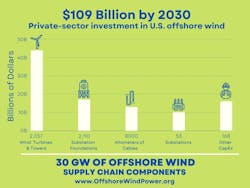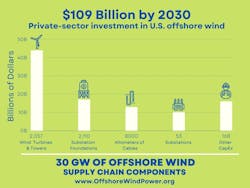Offshore wind in the US a once-in-a-generation opportunity
Editor's note: This story first appeared in the September-October 2022 issue of Offshore magazine's first annual Offshore Wind Special Report. Click here to view the full Offshore issue or click here to view the special report.
By Kris Ohleth, Special Initiative on Offshore Wind
It is a rare and special thing to witness the birth of an industry. Imagine being there to watch the first Model T roll down the streets of your town or to be the first one with an electric light bulb hanging over your kitchen table.
Offshore wind energy presents just that opportunity: a once-in-a-generation opportunity to bring enormous economic, environmental and energy systems benefits to the US.
Offshore wind is a technology that has been delivering energy and other positive attributes to countries around the world for more than 30 years. Right now thousands of wind turbines are spinning in numerous countries in Europe and Asia. In addition to generating more than 55 GW of electricity worldwide, which is powering millions of homes, offshore wind is also delivering tens of thousands of good-paying jobs and a skilled workforce, all while providing environmental benefits and energy security.
Currently, the US has only seven wind turbines offshore, which comprise two demonstration-scale projects. Compared with the development of offshore wind globally, this is a paltry sum. However, the future is bright for US offshore wind and will bring energy independence to the nation.
For the first time in history, the US has set a national target for developing offshore wind: 30 GW by 2030. This is an exciting and ambitious goal that has provided a beacon for those in the sector. This level of development will provide tens of thousands of jobs and millions of dollars in economic activity.
Indeed, the economic benefits of building out to the 30-GW goal is clear. A recent report by the Special Initiative on Offshore Wind provides analysis that shows that the level of economic activity available through private investments to the supply chain is $109 billion. This is an incredible opportunity, providing an injection to the US economy equal to nearly half the size of the budget for the entire state of Louisiana.
Leasing activity
The areas off the coast that are needed for offshore wind development are leased by the Bureau of Ocean Energy Management (BOEM), an agency in the US Department of the Interior. While one of the lesser-known agencies of the federal government, they are one of the largest revenue-generating agencies for the US Treasury, as it collects revenues from offshore oil and gas generation as well as from renewable energy projects, like offshore wind.
The majority of the leasing activity for offshore wind has been on the Atlantic Coast. However, in July of this year, BOEM released a request for comments on two draft Wind Energy Areas (WEAs) in the Gulf of Mexico (GoM). The first WEA would be located about 24 miles off the coast of Galveston, Texas, covers a total of 546,645 acres and has the potential to power 2.3 million homes with clean wind energy. The second WEA would be located about 56 miles off the coast of Lake Charles, Louisiana, covers a total of 188,023 acres and has the potential to power 799,000 homes.
These new areas proposed in the GoM are another important indicator that the nation is on the precipice of an energy transition.
While most of the offshore wind turbines in the country will be too far to see from shore, there is no doubt that the industry will experience the profound economic, environmental and energy system benefits that follow.
Kris Ohleth is director with Special Initiative on Offshore Wind, a decade-old independent policy think-tank devoted to the responsible and sustainable development of offshore wind in the US.


